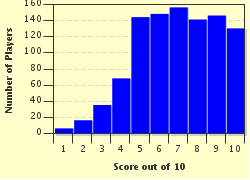Quiz Answer Key and Fun Facts
1. A is for what part of the neurone that carries impulses away from the cell body?
2. Which B is the name of the stem-like portion of the brain connecting the two cerebral hemispheres to the spinal cord?
3. Which C is the convoluted grey matter on the outer surface of the cerebral hemispheres?
4. Which D is for the threadlike extensions of neurone cytoplasm?
5. This E is for a disease that causes excessive electrical activity in the brain.
6. Which F is the fold of dura mater separating the two cerebral hemispheres?
7. This G is the ninth cranial nerve.
8. Which H is a paralysis that affects half of the body?
9. I is for the islands of Reil. What is their other name, also beginning with I?
10. Which J form of epilepsy is marked by localized spasms?
Source: Author
leith90
This quiz was reviewed by FunTrivia editor
crisw before going online.
Any errors found in FunTrivia content are routinely corrected through our feedback system.


